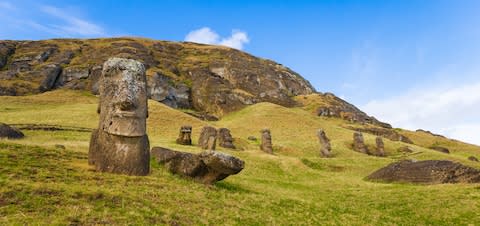Forget museums – the only place to see Easter Island's famous statues is where they were created

The lonely triangle of rock known as Rapa Nui (to the locals), Isla Pascua (to the Chilean colonists) and Easter Island (to the rest of us) is everything you imagine it to be.
Drive, cycle or hike around its 40 miles of shore and your first thought is: wilful extinction. Or, in more prosaic terms: no trees. It’s believed the people of Rapa Nui chopped down all the native giant palm trees some time after their arrival from western Polynesia in the 12th century, probably to build canoes and shelter. Certainly when the Dutch arrived in 1722 the island was basically barren.
What remains is grassland and scrub, outcrops of hawaaite and basalt and patches of scree on the slopes. On each of the island’s vertices are extinct volcanoes. It is a stark, strange and solitary place for humans to make their home.
It also provides a dramatic backdrop to Rapa Nui’s main attraction: the monolithic mega-heads known as moai. Some 887 have been counted to date dotted around the edges of the island. The “dotting” is partly man-made. Since the first removal of a moai, Hoa Hakananai’a, in 1869 by the crew of HMS Topaze – now controversially on display in the British Museum – as many as 79 complete moai, we well as heads, torsos, topknots known and pukao, and smaller moai figurines have been relocated – some moved to museums including the island’s own excellent Museo Antropológico Padre Sebastián Englert.
Many moai (a Polynesian word for “statue”) were found toppled or broken. Some fully-carved ones seem to have been abandoned during their final journeys. The trees that were felled were almost certainly used to aid in the transporting of the figures, which reach heights of more than thirty feet and weigh as much as 80 tons. Archaeologists believe that the bearers may have believed that the gods had willed the falling of some moai and were unwilling to raise them up again.

The moai stand on plinths known as ahu. The largest, Ahu Tongariki – the site of 15 figures – is also the most photographed. On the white coral beach of Anakena are two ahu: one has seven heads and the other a solitary, wide-bodied moai, watching over those who swim in the roiling surf. Only one, Tukuturi, has legs. The moai at Ahu Huri A Urenga has four hands. The quarry known as Rano Raraku, with its unfinished moai and fallen figures is perhaps the most evocative spot on the entire island. One partially carved moai is particularly gargantuan, about 71 feet long, prompting speculation that the nobles who commissioned these moai pushed the artisans too far – and so they downed their tools.
The functions of the moai are not fully understood. Did they channel a spiritual power known as mana? Do they represent ancestors? Were they related to astronomy? Were there original locations symbolic? Do the great majority face inland to protect the islanders or because looking out to sea was pointless – did the inhabitants of Rapa Nui believe they were the only people on Earth?

The sheer bulk, the eyeless gaze, the lofty brow, cannot but stir the onlooker. Twenty-first century Easter Islanders work in tourism as hotel guides, cooks and cleaners. They serve in the shack-like restaurants and shops around the little “capital” Hanga Roa. They surf, play rugby (it rivals footy here), dance to their pulsing Polynesian music. A handful work as performers in reenactments of indigenous culture of varying quality.
But the moai declare, silently: here lived a serious and cerebral people. There is a strange, beguiling nobility to the moai, which makes a trip to the bare plinth that is Easter Island a near-mystical experience; in a museum, you come upon the stone face, perhaps marvel a moment and move on, but in situ you slow down, listen to the wind, look up at the empty sky, and commune with the stone sentinels.

More than moai: Rapa Nui’s other sights
1. Petroglyphs
Go with a local guide to see the Birdmen (Tangata manu) paintings at Aka Kai Tangata aka the “Cannibal Cave”, harking back to an ancient egg collecting competition and associated Birdman cult, a successor to the Ancestor Cult of the moai.
2. Diving
Scuba divers can explore caverns and lava tubes, see young corals and even an underwater moai in the clear waters around the island. The Rapa Nui marine park, roughly the size of the Chilean mainland, is one of the largest marine protected zone on earth, and a home to at least 142 endemic marine species, including 27 threatened with extinction.
3. Cycling
Hire a bike and hit the coast road – it’s a great way to see out of the way moai and there are hardly any inclines; take plenty of water, a hat and sun cream.
4. Dine at La Kaleta
A Chilean ceviche at this popular restaurant is the best way to try the locally caught tuna; grilled fish with quinoa, caldillos (soups) and seafood pastas are also available. Tel + 56 32 255 2244
5. Kayaking
See secret beaches, islets and seabirds on a group kayaking excursion; these trips usually include snorkelling.

More information in Chris Moss’s Easter Island “Trip of a Lifetime” article.
Visit the website of the Latin American Travel Association for a list of tour operators.


